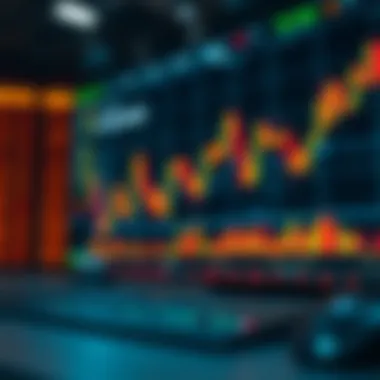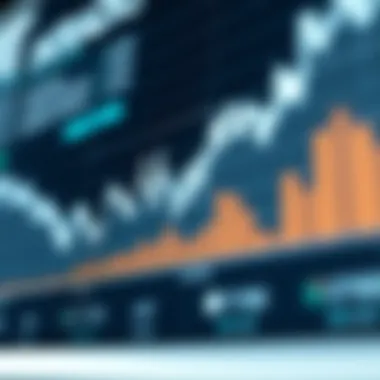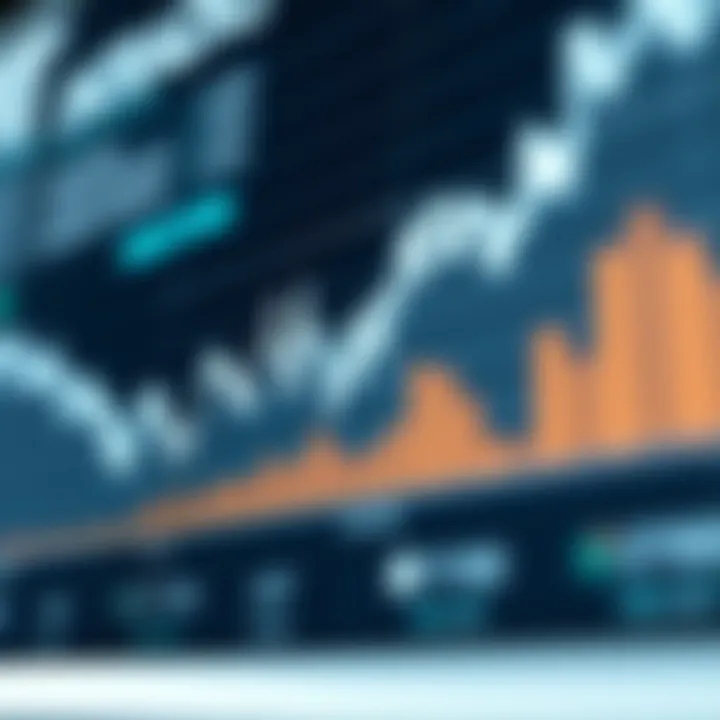Mastering Index Futures Trading: A Complete Guide


Investment Terminology
Understanding the language of index futures trading is pivotal for both newcomers and seasoned investors. Mastering this terminology not only empowers you with a clearer grasp of market dynamics but also enhances the efficacy of your trading strategies.
Key Definitions
Index Futures: These are standardized agreements to buy or sell a specific index, like the S&P 500, at a predetermined price on a specified future date. Essentially, they mirror the performance of the underlying index.
Leverage: This refers to using borrowed capital for investment, amplifying both potential gains and losses. In the context of index futures, traders often require a margin, which is a fraction of the total contract value, showcasing how leverage works.
Margin Requirement: This is the minimum amount of capital a trader needs to open or maintain a position in index futures. The margin requirement can fluctuate based on volatility and market conditions.
Settlement: The process where the contracts are resolved, either through cash settlement or physical delivery of the underlying index.
Commonly Used Terms
When navigating the index futures landscape, these terms frequently appear:
- Long Position: This indicates that a trader has bought futures contracts with the expectation that the index will rise.
- Short Position: Here, a trader sells futures contracts anticipating that the index will decline in value.
- Contract Size: This denotes how much value one contract represents in terms of the underlying index. For example, one E-mini S&P 500 futures contract represents $50 times the S&P 500 index value.
- Expiration Date: The date on which the futures contract is either settled or becomes void.
Expert Advice
Arming yourself with insightful strategies can be the difference between triumph and turmoil in index futures trading. Here are some advantageous tips to steer your approach.
Investment Strategies
- Trend Following: This strategy involves identifying the prevailing direction of the index and making trades in the same direction. It’s crucial to stay aware of market sentiment and macroeconomic indicators that may influence trends.
- Hedging: By taking a position in index futures, investors can protect their existing investments against market downturns. For instance, if you hold significant equity positions, shorting index futures can offset potential losses.
- Diversification: Engaging in various index futures, rather than concentrating on a single product, can reduce risk exposure. Investors should look into different sectors and indices to find opportunities.
Risk Management Tips
To navigate the choppy waters of index futures trading, adhering to sound risk management principles is fundamental:
- Set Stop-Loss Orders: These orders automatically close positions when the price reaches a certain level, limiting losses.
- Regular Portfolio Review: It’s essential to reassess your positions and overall strategy periodically to ensure alignment with your financial goals.
- Start Small: Particularly if you’re new to futures trading, consider beginning with a smaller amount of capital. This allows you to test the waters before diving in headfirst.
"Success in trading is not about predicting the markets perfectly, but about managing risk wisely."
To deepen your understanding of index futures trading, explore sources like Investopedia and CME Group, where you can find further insights into trading methodologies and market trends.
Understanding Index Futures
In the realm of finance, index futures serve as a pivotal instrument for traders and investors alike. They not only facilitate speculation on the direction of stock indices but also provide a means for portfolio diversification and hedging strategies. A grasp of index futures is essential for anyone who aims to navigate today’s complex trading landscape. The efficacy of trading decisions often rests on one’s understanding of these financial derivatives.
Definition and Mechanics
Index futures are contracts that obligate the buyer to purchase, or the seller to sell, a specific financial index at a predetermined price at a future date. The mechanics of these instruments are quite straightforward but can be deceptively intricate. They are designed to track the performance of an index, such as the S&P 500 or the NASDAQ-100, and they enable traders to speculate on future movements without requiring ownership of the actual underlying assets.
Trading index futures involves several key components:
- Contract Value: This refers to the multiplied value of the index. For example, if the S&P 500 is at 4000 and the contract size is $50, the total contract value would be $200,000 (4000 x 50).
- Leverage: The beauty of index futures lies in their ability to amplify potential returns. Traders only need to put down a fraction of the total contract value as margin, which can significantly enhance gains, but also risks.
- Settlement: Most index futures are cash-settled, meaning that at expiration, no physical delivery of assets occurs. Instead, the difference between the entry price and the final price is exchanged in cash, simplifying the process.
By comprehending these mechanics, traders can make informed decisions and tailor their strategies to maximize outcomes.
Historical Context
The journey of index futures trading began in the early 1980s. Originating in the US with the launch of the S&P 500 futures contract, these financial instruments opened a new frontier for traders. The aim was to create a centralized marketplace for managing risks associated with fluctuating stock prices.
In 1982, the Chicago Mercantile Exchange introduced the S&P index futures, which quickly gained traction among investors for hedging against market downturns. This development significantly transformed trading practices, allowing participants to hedge their portfolios rather than find themselves cornered in market volatility.
Over the decades, index futures have evolved alongside technological advancements and growing market complexities. By the late 1990s and into the 2000s, the introduction of electronic trading platforms revolutionized how index futures are accessed and traded, making them more accessible to individual investors. Understanding this historical backdrop provides valuable insight into the current functioning of index futures in the financial market.
Key Participants
The landscape of index futures trading features a diverse array of participants, each playing a crucial role in the dynamics of this market. Understanding who these players are is essential for grasping how the market operates.
- Hedge Funds: Known for their sophisticated trading strategies, hedge funds utilize index futures to hedge risks or speculate on market movements. They are often seen as influential participants, driving substantial trading volumes.
- Institutional Investors: Including mutual funds and pension funds, these entities often use index futures to manage exposure, hedging their entire portfolios or specific sectors against potential downturns.
- Retail Traders: Individual investors have increasingly joined the fray, drawn by the leverage and liquidity that index futures offer. They often employ various strategies to capitalize on price movements, although they can also bear heightened risks due to their less extensive trading experience.
- Market Makers: Providing liquidity and ensuring smooth trading, market makers play a fundamental role in the functioning of index futures. They help maintain balanced markets, facilitating trades between buyers and sellers.
In sum, the array of participants affects the pricing of index futures, and their collective behavior can have significant implications for the market.
"Understanding the diverse players involved is just as important as mastering the technical aspects of trading index futures."
A firm grasp on the definitions, mechanics, historical context, and key participants lays a solid foundation for further exploration into the benefits and risks of trading index futures.
Benefits of Trading Index Futures
Understanding the perks of index futures trading is like finding a shiny penny in a pile of change. This section dives into key benefits that could turn the tide in your trading journey, especially for the savvy investor looking for an edge in the market. You can employ these financial instruments not just to speculate, but also to manage risk and optimize your investment portfolio.
Leverage Effects
One of the standout features of trading index futures is the concept of leverage. By allowing traders to control a significant amount of capital with a relatively small investment, investors can amplify potential gains. For instance, if you have a margin requirement of 5%, you can control a contract worth $100,000 with just $5,000. It’s a bit like walking a tightrope; one small misstep could lead to significant losses, but if you plan and practice, the rewards can be substantial. This kind of leverage is particularly appealing for those looking to maximize their returns, but it’s not without its pitfalls, as a slight downturn in the market can wipe out your investment.
Hedging Capabilities
Next on the docket is the hedging capacity index futures offer. For market participants wanting to shelter their portfolios from the potential of adverse price movements, hedging via index futures acts as an insurance policy. Say you hold a variety of stocks in a tech-heavy portfolio. If you sense a downturn in the tech sector, selling futures contracts can help offset those potential losses. This approach allows savvy investors to protect their interests without needing to liquidate their positions entirely. Notably, many institutional players like pension funds routinely use these contracts to manage their risk exposure.
Liquidity Considerations
Liquidity is the name of the game in index futures trading. The market for these contracts is often more liquid than individual stocks, meaning you can enter and exit positions more easily without causing disruptions to the market price. High liquidity often translates to tighter bid-ask spreads, which ultimately is a boon for any trader. In practice, this means you’re less likely to suffer from slippage—the difference between expected and actual execution prices. Furthermore, during periods of market stress, liquid markets provide an avenue for exit strategies that might not be available in other financial instruments.
"Liquidity provides a safety net in trading, making it easier to act when the market moves unexpectedly."
In summary, the benefits of trading index futures are plentiful, drawing in both ambitious new traders as well as seasoned veterans. From harnessing leverage for greater potential returns, to using these contracts as a hedge against risks, and enjoying the advantages of high liquidity, understanding these benefits is crucial in crafting a comprehensive trading strategy.


As you navigate this intricate landscape, keep these benefits in mind. They can serve as guiding stars, illuminating your path in the world of index futures trading.
Risks Involved in Index Futures Trading
Understanding the risks inherent in index futures trading is crucial for investors looking to navigate this intricate market. While index futures can offer immense opportunities, they also come with their fair share of uncertainties that could significantly affect an investor's portfolio. These risks can take various forms and require a careful examination to manage them effectively. Having insights into these risks empowers traders to make informed decisions, thereby safeguarding their investments and improving their trading strategies.
Market Volatility
Market volatility is a hallmark of index futures trading. Prices can swing wildly due to numerous factors such as economic data releases, geopolitical events, or even just market sentiment. This volatility can lead to substantial gains, but it can equally result in steep losses. The unpredictable nature of the market means that one must be prepared for sudden shifts that could impact positions overnight.
Consider this: if a trader holds a futures contract against an index that suddenly plummets due to poor employment figures, they could face significant losses. Conversely, a positive earnings report can cause prices to soar. Thus, it’s essential for traders to be vigilant and have a rock-solid strategy that incorporates risk tolerance levels and exit strategies to minimize potential damage against unforeseen market swings.
"Volatility is the price of admission to the investment universe, and every investor must be ready to weather the ups and downs to reap potential rewards."
Liquidity Risk
Liquidity risk is another critical concern. Index futures need a vibrant market to ensure that positions can be entered or exited swiftly without significantly impacting the price. In periods of low liquidity, even well-researched trading decisions can backfire, as a trader might struggle to execute a trade at the desired price. The lack of willing buyers or sellers can lead to higher transaction costs, which further exacerbates losses.
For instance, imagine a trader who can’t sell their contract because few participants are willing to trade at that moment. The result? They may end up selling below their target price, which chips away at their overall profitability. This highlights the importance of monitoring trading volumes and understanding the market dynamics at play, as getting caught in a liquidity trap can spell disaster for even the most seasoned traders.
Leverage Risks
Leverage is a double-edged sword in the world of index futures. While it magnifies potential profits, it equally amplifies potential losses. When traders use leverage, they essentially borrow funds to increase their position size beyond their actual capital. This means that even a small market movement can yield significant changes in a trader's account balance.
For example, if a trader is leveraging their capital to trade with a 10:1 ratio, a mere 1% drop in the index could wipe away 10% of their investment. Thus, understanding one’s risk appetite and financial capacity is paramount when employing leverage.
In short, it’s critical to have a well-thought-out leverage strategy. Traders should establish limits on how much they are willing to risk on leveraged positions, keeping in mind their overall trading plan and market conditions.
Essential Strategies for Trading
Understanding and implementing effective strategies is critical when trading index futures. This section elucidates various approaches, arming traders with the knowledge to navigate this complex market landscape. A solid strategy not only shapes the trading process but also bolsters risk management, which is paramount for long-term success. By adopting specific strategies, traders can better optimize their efforts and enhance the potential for profit.
Trend Following
Trend following is a strategy that involves identifying and trading in the direction of the prevailing market trend. The crux of this tactic lies in the adage, "the trend is your friend." Traders look for upward or downward movements and enter positions that align with these trends. This method can be appealing, particularly in the world of index futures, as trends can often persist for extended periods. Tools such as moving averages or momentum indicators aid traders in determining when to enter or exit a trade.
Adopting a trend-following strategy requires recognizing the right moments. Here’s a few points to consider:
- Entry and Exit Points: Look for signals that suggest a strong trend is either forming or reversing.
- Risk Management: Employ a stop-loss order to mitigate potential losses if the trend fails to manifest as expected.
- Continuous Monitoring: Staying abreast of market developments is vital, as trends can shift rapidly.
"In trading, as in life, what we see is often not the whole picture; trends are just one aspect of the unfolding narrative."
Swing Trading Techniques
Swing trading is another popular strategy, particularly for those who prefer to capture shorter-term price movements. Unlike day trading, which involves capitalizing on price fluctuations over the course of the day, swing trading allows traders to hold positions for several days or weeks. This method seeks to exploit the natural price 'swings' in an index, aiming for better entry and exit points.
Key aspects of swing trading include:
- Chart Analysis: Utilizing charts to identify patterns and potential reversals. Traders often analyze candlestick formations or Fibonacci retracements to gain insights.
- Targeting Price Levels: Set profit targets based on past price levels to improve the chances of success.
- Flexibility: It’s essential to remain adaptable, as market dynamics can affect predicted price movements.
Mastering swing trading can take practice, but the rewards can be significant if done correctly.
Arbitrage Opportunities
Arbitrage involves taking advantage of price discrepancies in different markets or forms. For index futures, this strategy might include simultaneously buying and selling equity index futures against related stocks or ETFs. The goal is to lock in a profit through differential pricing.
Several considerations are crucial when exploring arbitrage:
- Speed: Time is of the essence; traders must act quickly to exploit narrow price gaps.
- Cost Efficiency: Consider transaction fees, as these can erode potential profits.
- Market Knowledge: A thorough grasp of the financial instruments and their relationships is essential to identify viable arbitrage opportunities.
While arbitrage strategies can expose traders to low risk, they require a substantial investment in terms of time and resources to monitor the markets continuously.
Market Influences on Index Futures
The dynamics of index futures are significantly swayed by various market influences. In understanding this topic, one must appreciate how economic indicators, geopolitical events, and technological changes collectively shape the trading landscape. These influences not only impact prices but also dictate trader sentiment and market movements. Recognizing these elements is crucial for traders looking to make informed decisions in a fast-paced environment.
Economic Indicators
Economic indicators serve as essential barometers for gauging the health of an economy. They not only reflect past performance but also help project future economic conditions. Here are a few key indicators that traders should keep a close eye on:
- Gross Domestic Product (GDP): A growing GDP usually suggests a healthy economy, influencing bullish sentiment among traders. Conversely, a decline may indicate recessions, creating bearish pressure.
- Unemployment Rates: High unemployment often correlates with decreased consumer spending, potentially impacting stock indices.
- Inflation Rates: Rising inflation can erode purchasing power and lead to shifts in monetary policy, causing volatility in futures markets.
By tracking these indicators, traders can better understand which direction the market might take. Tools like the Economic Calendar are invaluable in keeping up-to-date with releases that could affect the index futures landscape.
"Monitoring economic indicators can make the difference between a good trade and a great trade."
Geo-Political Events
The influence of geopolitical events on index futures cannot be overstated. Events ranging from elections to international conflicts can lead to heightened volatility in financial markets. Traders need to be aware of activities such as:
- Elections: Political transitions can bring about policy changes that may directly affect economies and, by extension, stock indices.
- Trade Agreements: New trade deals or sanctions can impact the finance of nations and influence investor confidence.
- Natural Disasters and Pandemics: Unforeseen events can cause market disruptions, influencing trader sentiment and prices of index futures.
Keeping an ear to the ground regarding international news helps traders make proactive decisions, minimizing potential losses from adverse market movements.
Technological Changes
The technology landscape continually evolves, often influencing market operations and trading strategies. Technological advancements lead to several notable impacts, such as:
- Algorithmic Trading: This automated approach leverages complex algorithms to execute trades at lightning speed, often capitalizing on very short-term movements. While it can enhance liquidity, it also introduces risks, especially during times of market stress.
- Data Analytics Tools: Traders utilize advanced tools for assessing vast amounts of data, allowing for more precise forecasting and strategy formulation.
- Blockchain Technology: The introduction of blockchain is slowly changing trading efficacies by promoting transparency and reducing costs in transactions.
Understanding these technological nuances can give traders an edge, enhancing their operational efficiencies and ultimately their effectiveness in the market.
Overall, the market influences on index futures are multifaceted. By keeping a close watch on economic indicators, geopolitical shifts, and technological advancements, traders can navigate the complexities of the market with more confidence, making informed and strategic trading decisions.


Understanding Index Futures Contracts
In the realm of financial markets, grasping the concept of index futures contracts is foundational for any investor looking to engage with these instruments effectively. Index futures are agreements to buy or sell a specific index at a predetermined price at a future date. This simple definition, however, belies the complexity and nuance involved in navigating these contracts. They not only serve as a means for hedge funds and sophisticated traders to manage exposure to market fluctuations but also provide opportunities for risk management and speculative trading.
By familiarizing oneself with the various components of index futures contracts, traders can better strategize their moves while understanding the risks and benefits that come along with these trades. This section is crucial for peeling back the layers of index futures trading, setting the stage for the more complex discussions that follow.
Contract Specifications
Contract specifications outline the fundamental framework of index futures. These details include the index being traded, the contract size, and the tick value—the minimum price movement of the contract. Customarily, futures contracts such as the S&P 500 or the Nasdaq-100 are popular choices due to their high liquidity.
- Index Traded: Identifying which index you are trading is critical. Each index has its own dynamics and market behaviors.
- Contract Size: Typically, a contract may represent a value equivalent to a specific multiplier of the index level. For instance, one S&P 500 futures contract might represent $50 times the index value.
- Tick Value: Understanding how much a single tick movement affects your position is essential for managing your profits and losses.
Each of these specifications can impact not just the trading strategy employed but also the overall risk exposure of a trader. Therefore, getting the hang of these details helps you play your cards right when entering and exiting positions in the index futures market.
Expiration Dates and Settlement
Expiration dates indicate when the contract will cease to exist, and how contracts settle is a pivotal aspect of futures trading. Most index futures are settled in cash rather than physical delivery, meaning that the difference in value between the purchase and sale will simply result in a cash transfer run at expiration.
Investors must keep an eye on the expiration dates to avoid holding positions too close to expiry, as volatility can spike leading to unfavorable price movements. For example:
- First Notice Day: This is the first day on which a buyer of the contract might be called to take delivery. In practical terms, this means it's generally best to exit a position before this day.
- Last Trading Day: This day typically marks the final opportunity to close a position before the contract settles.
- Settlement Price: Understanding how the index’s settlement price is calculated at expiration can help traders formulate strategies around closing positions.
Since index futures contracts are typically settled based on the index’s closing value on the expiration date, being prepared for rapid swings in market conditions is crucial.
Margin Requirements
Margin requirements are the funds needed to open and maintain a position in index futures. These are different from the concepts of payment due for stocks in a cash trade. In futures trading, there are initial margin and maintenance margins:
- Initial Margin: This is paid upfront when opening a position. It's a fraction of the total contract value, allowing traders to leverage their investments. A common scenario would involve a trader putting down 5% to 10% of the total contract value.
- Maintenance Margin: This is the minimum balance that must be maintained in the trading account. If your account balance falls below this threshold due to losses, you will receive a margin call, prompting you to fund your account to continue trading.
Overall, selecting the right margin strategy can make or break your trading effort. It allows for a controlled exposure to market movements while limiting risk. Understanding how margins work not only plays a large role in how much capital you need to invest but also in managing the potential impact on your overall trading portfolio.
Technical Analysis in Index Futures
Technical analysis plays a pivotal role in the realm of index futures trading. The core aim of this analysis is to gauge market movements using past price data and trading volume, allowing traders to make more informed decisions amid fluctuations. This approach goes beyond mere speculation; it relies on patterns and statistics that arise from historical data. By sticking to this method, traders might just find clear indicators of future price movements.
One significant aspect about technical analysis involves a variety of charting techniques that visually display price trends, offering insights into market psychology. Understanding these patterns can provide traders with vital signals, helping them discern when to enter or exit trades.
Chart Patterns
Chart patterns represent the heartbeat of technical analysis. These formations come in numerous shapes, each offering unique insights into market behavior. A few noteworthy patterns include the head and shoulders, triangles, and flags.
- Head and Shoulders: Often indicates a trend reversal. This is a pattern that can signal a shift from bullish to bearish sentiments.
- Triangles (ascending, descending, symmetrical): Indicate a period of consolidation and can suggest potential breakouts or breakdowns.
- Flags and Pennants: These are continuation patterns that showcase a brief pause in the prevailing trend before it resumes.
Knowing how to recognize these patterns can shift a trader's perspective and strategy, making it an invaluable skill set. Traders typically consult these formations to predict significant price movements, thereby refining their trading approach.
Analytical Tools
To bolster the effectiveness of chart patterns, traders often employ various analytical tools. Indicators like moving averages, Relative Strength Index (RSI), and Bollinger Bands are commonly utilized to interpret trends and price momentum.
- Moving Averages: This smoothens away price fluctuations, allowing traders to focus on the overall trend rather than daily noise.
- Relative Strength Index (RSI): Provides insights into whether an index is overbought or oversold, thus guiding traders on potential entry points.
- Bollinger Bands: Offers a visual understanding of price volatility. When prices touch the bands, especially in conjunction with other indicators, it may signal strong potential trade setups.
Each analytical tool can significantly enhance traders' ability to predict market behavior. The key lies in concisely combining these tools to support decision-making.
Risk Management Practices
Even the most informed traders can't escape the underlying risks. That's where sound risk management practices come into play. Traders must develop a coherent risk strategy to safeguard their investments. This might include setting stop-loss orders or defining clear risk-reward ratios before entering a trade.
- Stop-Loss Orders: These are automatic orders set to sell a security when it reaches a certain price, effectively limiting potential losses.
- Position Sizing: Understanding how much to risk per trade is crucial. Ideally, a trader should risk a small percentage of their capital on a single trade to prevent catastrophic losses.
- Diversification: By spreading investments across various index futures, a trader can mitigate risks associated with market volatility and unforeseen events.
"In the world of trading, it's not merely about making profit; it's about preserving capital."
A disciplined risk management framework will not only protect investor capital but also allow for sustainable trading practices in the ever-changing landscape of index futures.
By mastering technical analysis alongside rigorous risk management, traders can approach index futures with more confidence, positioning themselves for success.
Fundamental Analysis of Index Futures
Fundamental analysis plays a pivotal role in index futures trading, as it provides insights into the underlying forces that drive market movements. Unlike technical analysis, which relies on charts and historical prices, fundamental analysis digs into economic indicators, corporate earnings, and various other factors that impact market sentiment. By understanding these elements, traders can better position themselves to make informed decisions, mitigating risks while seizing advantages in a fast-moving market.
Interpreting Economic Data
Economic data acts as the pulse of a country’s financial health and influences investor behavior. Key indicators to keep an eye on include GDP growth rates, employment figures, and inflation rates. For instance, if a country reports strong GDP growth, it generally signals a robust economic outlook, often leading to a rise in stock market indices. Conversely, dismal job reports can paint a bleak picture, potentially resulting in a downward shift in index futures.
"Understanding the narrative behind numbers is as significant as the figures themselves."
To interpret this data effectively, traders should consider the broader economic context. Analyzing trends over time rather than focusing solely on individual reports enhances perspective. For example, a rising unemployment rate occurring alongside increasing inflation—a scenario known as stagflation—can create unpredictable market conditions. Engaging with dashboards that aggregate economic indicators, like those on tradingeconomics.com, can provide timely insights.
Analyzing Company Performance
The performance of key companies within an index can have a substantial impact on index futures. When major corporations release earnings reports, these disclosures can sway overall market sentiment. Keep in mind that a positive earnings report from a leading tech firm can lift the entire index, while a quantifiable shortfall can cause a ripple effect downwards.
Traders should consider metrics like earnings per share (EPS), revenue growth, and profit margins when evaluating company performance. Monitoring news on platforms such as seekingalpha.com can be helpful in staying updated on any trends or red flags that might affect these companies.
This analysis needs to be balanced with an understanding of sector trends. For instance, an earnings miss in the energy sector might be less alarming during a period of economic expansion, but could resonate differently in a downturn, affecting overall index performance.
Sector Impacts on Index Movement
The composition of sectors within an index can significantly influence its movements. For example, if technology stocks dominate an index, developments like advancements in AI might drive upward momentum, while issues in the financial sector could pull it down.
Understanding how different sectors respond to economic conditions is vital. A sector's sensitivity to interest rates, commodity prices, or government policies can offer clues about potential index volatility.
Consider the following:


- Cyclical Sectors: These sectors perform well when the economy is strong, such as consumer discretionary and technology.
- Defensive Sectors: Tend to be more stable during economic downturns, like utilities and healthcare.
By analyzing sector performance, traders can pinpoint opportunities where they believe an index may deviate from its expected movements. Sector rotation strategies can lead to better timing for entry and exit points in index futures trading.
Regulatory Aspects of Index Futures
Regulation plays a crucial role in index futures trading, shaping the landscape in which these financial instruments operate. It's not just about following the rules; it's about creating a framework that fosters trust and stability in the markets. Investors, whether seasoned pros or newcomers, need to understand how regulations impact their trading, as these rules can significantly influence market dynamics and the overall trading environment.
Key Regulations
The regulation of index futures revolves around several key statutes and guidelines established by governing bodies. In the United States, the Commodity Futures Trading Commission (CFTC) is the primary regulator, ensuring that the futures markets are transparent and fair. Here’s a breakdown of significant regulatory components impacting index futures trading:
- The Commodity Exchange Act (CEA): This act provides the legal foundation for futures trading in the U.S. It aims to promote fair trading practices and protect against price manipulation.
- Dodd-Frank Wall Street Reform and Consumer Protection Act: Instituted after the 2008 financial crisis, this act brought about numerous changes, including increased oversight of derivatives markets and requiring more transactions to occur on exchanges or swap execution facilities.
- Regulation AT: Specifically targeting algorithmic trading in the futures market, Regulation AT ensures that firms using advanced trading strategies have proper risk controls in place.
Understanding these regulations helps traders grasp the legal landscape they operate within and ensures they align their strategies with compliance requirements.
Compliance Considerations
Complying with trading regulations is not just about avoiding penalties; it establishes the credibility of traders and their operations. Here are some major compliance considerations:
- Reporting Requirements: Traders must ensure timely and accurate reporting of their trades. This fosters transparency and helps regulatory bodies keep tabs on market activities.
- Recordkeeping: Maintaining comprehensive records is mandatory. This means keeping track of transactions, client communications, and any relevant correspondence that pertains to trading activity.
- Risk Management: Regulated entities often need to implement robust risk management frameworks to identify, assess, and mitigate risks that can affect their trading operations. The CFTC encourages firms to have safeguards in place to prevent market disruptions.
These compliance measures can seem burdensome but understanding them provides traders with knowledge and insight, helping them navigate potential pitfalls in the market.
Role of Exchanges
Exchanges serve as the bedrock of futures trading, acting as both a marketplace and a regulatory authority. They ensure that the trades conducted are fair and can also facilitate transparency in price discovery. Some essential roles played by exchanges include:
- Market Integrity: Exchanges implement rules to maintain market fairness and integrity. They regulate trading practices and impose penalties for misconduct, ensuring a level playing field for all participants.
- Liquidity Provision: By providing an organized platform for trading, exchanges contribute to market liquidity. This allows traders to enter and exit positions without substantial changes in price, enhancing overall trading efficiency.
- Education and Resources: Many exchanges offer educational materials and tools for traders to enhance their understanding of market mechanics and regulatory obligations.
In summary, the regulatory aspects of index futures trading form the backbone of a credible trading environment, safeguarding both players and the integrity of the financial system. Staying informed and compliant not only minimizes risks but also empowers traders to make educated decisions.
"Regulations can be seen as a guide in the tumultuous seas of trading; by understanding them, one can navigate towards success without running aground."
For further insights, you can explore regulations at CFTC or learn about trading practices on Investopedia.
Understanding the legal landscape is essential not only for compliance but also for strategic positioning in the futures markets.
Emerging Trends in Index Futures Trading
The landscape of index futures trading is continually evolving, driven by advancements in technology and shifting market dynamics. Understanding emerging trends in this area is crucial for investors looking to maintain a competitive edge. These trends can impact everything from trading strategies to risk management practices, thereby shaping an investor’s ability to navigate the market effectively.
Algorithmic Trading
Algorithmic trading is becoming increasingly prevalent within the realm of index futures. This method uses automated systems to execute trades based on pre-set conditions like price, timing, or quantity. Investors can benefit from algorithmic trading in several ways:
- Speed and Efficiency: Trades are executed faster than humanly possible, allowing for the capture of fleeting market opportunities.
- Reduced Emotional Bias: By relying on predetermined strategies, traders can minimize emotional decisions that might lead to irrational trading behavior.
- Data Analysis: Algorithms can analyze vast amounts of data swiftly, helping traders make informed decisions based on trends or anomalies in market behavior.
The precision of algorithmic trading means that it can effectively navigate the complexities of index futures, especially in a market fueled by rapid changes. In essence, it's like having a seasoned trader who doesn’t sleep, constantly monitoring the market and executing trades when conditions align.
Impact of Artificial Intelligence
Artificial intelligence (AI) is also carving out a significant role in index futures trading. AI can transform how investors analyze data and predict market movements. Here are a few critical aspects to consider regarding AI’s influence:
- Predictive Analytics: AI models can recognize patterns in historic market data, making forecasts about potential future movements. This capability gives traders a unique vantage point in anticipating trends in index futures.
- Risk Management: With AI-driven algorithms, traders can better assess risk exposure and adjust positions in real-time, optimizing their strategies based on ongoing market conditions.
- Personalized Trading Strategies: By utilizing AI, traders can develop tailored strategies that cater to their specific investment goals and risk tolerance.
AI-driven analytics not only improve the accuracy of trading decisions but also allow for greater adaptability in an ever-changing market landscape. It’s a game changer that’s helping investors stay ahead of the curve.
Sustainability and Ethical Considerations
As the trading world becomes more sophisticated, sustainability and ethical considerations are rising in importance. Investors are increasingly scrutinizing how trading practices impact broader societal and environmental contexts. Key points to consider include:
- Environmental Responsibility: With growing awareness of climate change, many traders are considering their impact on the environment. Sustainable investing strategies are being integrated into traditional trading practices.
- Ethical Trading Practices: Ensuring that trades are executed in a manner that is fair and transparent is becoming more paramount. This includes addressing issues like market manipulation and promoting integrity.
- Socially Responsible Investing (SRI): More investors are looking to align their trading activities with their personal values, opting for strategies that contribute positively to society.
"The future of trading is not just about profits; it’s about making an impact."
These trends represent a shift toward a more conscientious approach to investing, where financial success is balanced with ethical considerations. In sum, as index futures trading grows more sophisticated, acknowledging and adapting to these emerging trends is essential for long-term success.
Practical Tips for New Traders
Entering the world of index futures trading can feel like learning to ride a bike on a tightrope. There are numerous factors to consider, and navigating these can seem daunting for newcomers. However, practical tips can provide clarity and guidance. Understanding the nuances of trading is essential for success, as the environment is often fast-paced and volatile. New traders who equip themselves with the right knowledge can make informed decisions leading to fruitful outcomes.
Selecting a Broker
The first step in embarking on your trading journey is selecting a broker. It's a bit like picking a sidekick for your adventure. A suitable broker not only provides the platform for trading but also influences your overall experience. Here are a few critical points to keep in mind:
- Regulatory Standards: Ensure the broker is regulated by a reputable authority, as this adds a layer of protection for your funds.
- Trading Platform Features: Look for a user-friendly platform that aligns with your trading style. Check for tools like real-time quotes, charting capabilities, and order types.
- Fees and Commissions: Pay attention to the fee structure, which can impact your profitability. Compare research tools and educational resources among different brokers.
- Customer Support: A broker with responsive customer service can be invaluable when things go sideways. It’s crucial to have access to help when needed.
Selecting the right broker can ease your journey into index futures, helping you find your footing amidst fluctuating markets.
Developing a Personal Trading Plan
Once you've chosen a broker, the next step involves crafting a solid trading plan. Think of it as your game strategy—it sets the tone and guides your actions. A well-structured trading plan typically includes:
- Goals and Objectives: Define what you want to achieve, whether that be earning a certain amount or learning a skill within a time frame.
- Risk Management Strategies: Determine how much capital you are willing to risk on each trade and set stop-loss orders appropriately to limit potential losses.
- Entry and Exit Strategies: Identify specific criteria for entering and exiting trades based on your analysis methods.
- Evaluation Metrics: Regularly review your trades to analyze what worked and what didn’t. This reflection helps refine your approach over time.
"A good plan violently executed now is better than a perfect plan executed next week." - George S. Patton
A personalized trading plan provides a blueprint for navigating the choppy waters of index futures trading, ensuring that your decisions align with your overarching goals.
Maintaining Emotional Discipline
One of the most challenging aspects of trading is managing emotions. In the heat of the moment, it’s easy to let fear or impulsiveness take the wheel. Developing emotional discipline is key to consistency. Here are a few tips to keep your emotions in check:
- Stick to Your Plan: Adhere firmly to your trading plan. A good strategy helps take emotion out of the equation.
- Practice Mindfulness: Regularly check in with your emotional state. When you're aware of stress creeping in, it’s a sign to take a step back.
- Accept Losses: No trader wins all the time. Accepting losses as part of the learning process takes the sting out and allows for growth.
- Avoid Overtrading: It's tempting to jump into multiple trades, but overtrading often leads to diminished performance. Focus on a few well-thought-out opportunities instead.
Maintaining emotional discipline creates a solid foundation for your trading activities, allowing you to make rational decisions rather than acting on instincts.
Understanding and applying these practical tips can lay a strong groundwork for new traders and encourage steady progress in the realm of index futures trading.















